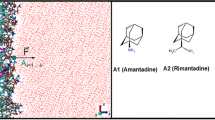Abstract
The 2009 influenza A virus pandemic, with high level of drug resistance reported, has highlighted the urgent need of more effective anti-influenza drugs. M2 channel proteins on the influenza A virus membrane have emerged as an efficient structure-based drug design target since variety of M2 channel protein structures were constructed by different experiment methods to generate the high resolution of crystal, solution NMR and solid-state NMR structure. In an effort to facilitate the future design of M2 channel inhibitors, the binding modes of 200 Adamantane-based drugs in four different types of M2 channel protein structures were evaluated by the critical interactions in terms of ligand binding affinity. The molecular docking results and statistic testing of binding affinity showed that the effect of each representative type from M2 channel protein structures was significantly different. Moreover, pharmacophore analysis revealed that there are two mechanisms of binding interactions to critical residues, Ser31 in holo structures and Ala30 in apo structures, respectively. Molecular docking studies, drug-like filters, and structure-based pharmacophore approaches successfully led us identifying the final hits reduced the false positives and false negatives in strategy of designing new potential group of future M2 channel inhibitors.







Similar content being viewed by others
References
Accelrys Inc. (2009) Discovery studio version 2.5 user manual. Accelrys Inc., San Diego
Alferes VR, Kenny DA (2009) SPSS programs for the measurement of nonindependence in standard dyadic designs. Behav Res Methods 41(1):47–54
Berman HM, Westbrook J et al (2000) The protein data bank. Nucleic Acids Res 28(1):235–242
Cady SD, Luo W et al (2009) Structure and function of the influenza A M2 proton channel. Biochemistry 48(31):7356–7364
Cady SD, Schmidt-Rohr K et al (2010) Structure of the amantadine binding site of influenza M2 proton channels in lipid bilayers. Nature 463(7281):689–692
Cross TA, Dong H et al (2012) M2 protein from influenza A: from multiple structures to biophysical and functional insights. Curr Opin Virol 2(2):128–133
Ertl P, Rohde B et al (2000) Fast calculation of molecular polar surface area as a sum of fragment-based contributions and its application to the prediction of drug transport properties. J Med Chem 43(20):3714–3717
Gandhi CS, Shuck K et al (1999) Cu(II) inhibition of the proton translocation machinery of the influenza A virus M2 protein. J Biol Chem 274(9):5474–5482
Hayden FG, Hay AJ (1992) Emergence and transmission of influenza A viruses resistant to amantadine and rimantadine. Curr Top Microbiol Immunol 176:119–130
Jing X, Ma C et al (2008) Functional studies indicate amantadine binds to the pore of the influenza A virus M2 proton-selective ion channel. Proc Natl Acad Sci USA 105(31):10967–10972
Kelly JM, Miles MA et al (1999) The anti-influenza virus drug rimantadine has trypanocidal activity. Antimicrob Agents Chemother 43(4):985–987
Kerr ID, Sansom MS (1993) Hydrophilic surface maps of channel-forming peptides: analysis of amphipathic helices. Eur Biophys J 22(4):269–277
Khurana E, Devane RH et al (2011) Computational study of drug binding to the membrane-bound tetrameric M2 peptide bundle from influenza A virus. Biochim Biophys Acta 1808(2):530–537
Kozakov D, Chuang GY et al (2010) Where does amantadine bind to the influenza virus M2 proton channel? Trends Biochem Sci 35(9):471–475
Le L, Leluk J (2011) Study on phylogenetic relationships, variability, and correlated mutations in M2 proteins of influenza virus A. PLoS ONE 6(8):e22970. doi:10.1371/journal.pone.0022970
Lipinski CA (2000) Drug-like properties and the causes of poor solubility and poor permeability. J Pharmacol Toxicol Methods 44(1):235–249
Lipinski CA, Lombardo F et al (2012) Experimental and computational approaches to estimate solubility and permeability in drug discovery and development settings. Adv Drug Deliv Rev 46:3–26
Monto AS (2008) Antivirals and influenza: frequency of resistance. Pediatr Infect Dis J 27(10 Suppl):S110–S112
Morens DM, Taubenberger JK et al (2010) The 1918 influenza pandemic: lessons for 2009 and the future. Crit Care Med 38(4 Suppl):e10–e20
Pielak RM, Chou JJ (2010) Flu channel drug resistance: a tale of two sites. Protein Cell 1(3):246–258
Pielak RM, Chou JJ (2011) Influenza M2 proton channels. Biochim Biophys Acta 1808(2):522–529
Pielak RM, Schnell JR et al (2009) Mechanism of drug inhibition and drug resistance of influenza A M2 channel. Proc Natl Acad Sci USA 106(18):7379–7384
Schnell JR, Chou JJ (2008) Structure and mechanism of the M2 proton channel of influenza A virus. Nature 451(7178):591–595
Sharma M, Yi M et al (2010) Insight into the mechanism of the influenza A proton channel from a structure in a lipid bilayer. Science 330(6003):509–512
Stouffer AL, Acharya R et al (2008) Structural basis for the function and inhibition of an influenza virus proton channel. Nature 451(7178):596–599
Tran L, Choi SB et al (2011) Discovery of potential M2 channel inhibitors based on the amantadine scaffold via virtual screening and pharmacophore modeling. Molecules 16(12):10227–10255
Trott O, Olson AJ (2010) AutoDock Vina: improving the speed and accuracy of docking with a new scoring function, efficient optimization, and multithreading. J Comput Chem 31(2):455–461
Wang J, Qiu JX et al (2011) Structural and dynamic mechanisms for the function and inhibition of the M2 proton channel from influenza A virus. Curr Opin Struct Biol 21(1):68–80
Wolber G, Langer T (2005) LigandScout: 3-D pharmacophores derived from protein-bound ligands and their use as virtual screening filters. J Chem Inf Model 45(1):160–169
Yi M, Cross TA et al (2008) A secondary gate as a mechanism for inhibition of the M2 proton channel by amantadine. J Phys Chem B 112(27):7977–7979
Acknowledgments
The work was funded by the Vietnam National Foundation for Science and Technology Development (NAFOSTED) under grant number 106.01-2012.66. Computing resources and support provided by the Institute for Computational Science and Technology—Ho Chi Minh City is gratefully acknowledged.
Author information
Authors and Affiliations
Corresponding author
Additional information
Nhut Tran and Linh Tran contributed equally to this study.
Rights and permissions
About this article
Cite this article
Tran, N., Tran, L. & Le, L. Strategy in structure-based drug design for influenza A virus targeting M2 channel proteins. Med Chem Res 22, 6078–6088 (2013). https://doi.org/10.1007/s00044-013-0599-z
Received:
Accepted:
Published:
Issue Date:
DOI: https://doi.org/10.1007/s00044-013-0599-z




